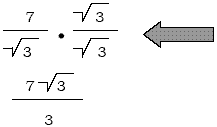|
TUTORIALS:
|
Rationalizing the Denominator
A. What It Means to Rationalize the Denominator
In order that all of us doing math can compare answers, we
agree upon a common conversation, or set of rules, concerning the
form of the answers.
For instance, we could easily agree that we would not leave an
answer in the form of 3 + 4, but would write 7 instead.
When the topic switches to that of radicals, those doing math
have agreed that a RADICAL IN SIMPLE FORM will not (among other
things) have a radical in the denominator of a fraction. We will
all change the form so there is no radical in the denominator.
Now a radical in the denominator will not be something as
simple as  . Instead, it will have a radicand which
will not come out from under the radical sign like . Instead, it will have a radicand which
will not come out from under the radical sign like  . .
Since  is an irrational number, and we need to
make it NOT irrational, the process of changing its form so it is
no longer irrational is called RATIONALIZING THE DENOMINATOR. is an irrational number, and we need to
make it NOT irrational, the process of changing its form so it is
no longer irrational is called RATIONALIZING THE DENOMINATOR.
B. There are 3 Cases of Rationalizing the Denominator
1. Case I : There is ONE TERM in the
denominator and it is a SQUARE ROOT.
2. Case II : There is ONE TERM in the
denominator, however, THE INDEX IS GREATER THAN TWO. It might be
a cube root or a fourth root.
3. Case III : There are TWO TERMS in the
denominator.
Let's study Case I:
Example:

Procedure: Multiply top and bottom by the
same radical.
 one term square root Look at
what is happening here! one term square root Look at
what is happening here!
 Since squaring is the opposite of taking
the square root, they cancel each other, leaving the 3 Since squaring is the opposite of taking
the square root, they cancel each other, leaving the 3
|